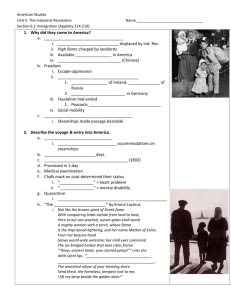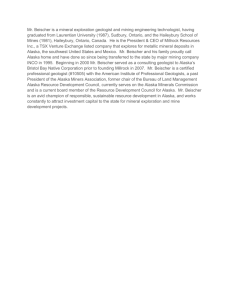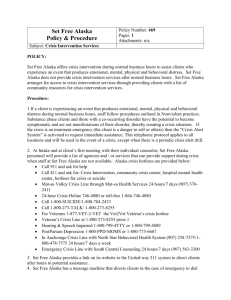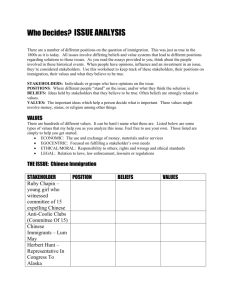Immigration Swells the Work Force (pages 70 and 71 in atlas)
advertisement
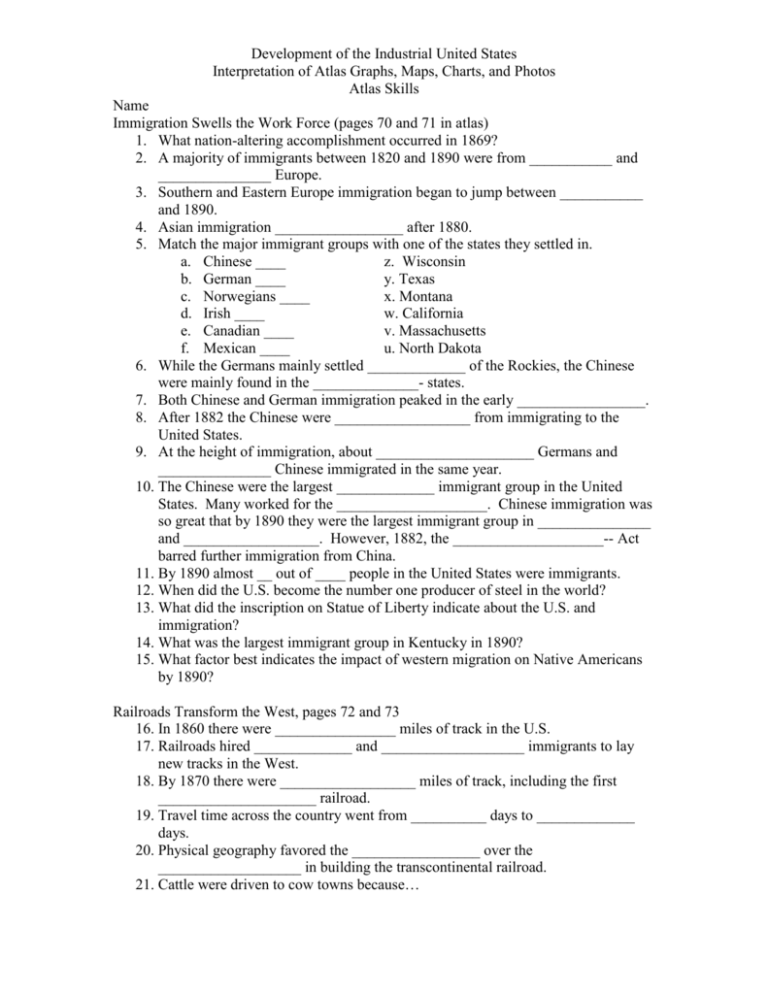
Development of the Industrial United States Interpretation of Atlas Graphs, Maps, Charts, and Photos Atlas Skills Name Immigration Swells the Work Force (pages 70 and 71 in atlas) 1. What nation-altering accomplishment occurred in 1869? 2. A majority of immigrants between 1820 and 1890 were from ___________ and _______________ Europe. 3. Southern and Eastern Europe immigration began to jump between ___________ and 1890. 4. Asian immigration _________________ after 1880. 5. Match the major immigrant groups with one of the states they settled in. a. Chinese ____ z. Wisconsin b. German ____ y. Texas c. Norwegians ____ x. Montana d. Irish ____ w. California e. Canadian ____ v. Massachusetts f. Mexican ____ u. North Dakota 6. While the Germans mainly settled _____________ of the Rockies, the Chinese were mainly found in the ______________- states. 7. Both Chinese and German immigration peaked in the early _________________. 8. After 1882 the Chinese were __________________ from immigrating to the United States. 9. At the height of immigration, about _____________________ Germans and _______________ Chinese immigrated in the same year. 10. The Chinese were the largest _____________ immigrant group in the United States. Many worked for the ____________________. Chinese immigration was so great that by 1890 they were the largest immigrant group in _______________ and __________________. However, 1882, the ____________________-- Act barred further immigration from China. 11. By 1890 almost __ out of ____ people in the United States were immigrants. 12. When did the U.S. become the number one producer of steel in the world? 13. What did the inscription on Statue of Liberty indicate about the U.S. and immigration? 14. What was the largest immigrant group in Kentucky in 1890? 15. What factor best indicates the impact of western migration on Native Americans by 1890? Railroads Transform the West, pages 72 and 73 16. In 1860 there were ________________ miles of track in the U.S. 17. Railroads hired _____________ and ___________________ immigrants to lay new tracks in the West. 18. By 1870 there were __________________ miles of track, including the first _____________________ railroad. 19. Travel time across the country went from __________ days to _____________ days. 20. Physical geography favored the _________________ over the ___________________ in building the transcontinental railroad. 21. Cattle were driven to cow towns because… Development of the Industrial United States Interpretation of Atlas Graphs, Maps, Charts, and Photos Atlas Skills Name 22. Cattle drives were no longer necessary by the late 1880s because… 23. _______________________ helped pay for the transcontinental railroads. 24. The U.S. __________________ provided all of the tracks railroads needed to expand. 25. Number the following events in the order in which they occurred. a. Only about 1,000 buffalo remain. b. 40 million buffalo roam the Plains. c. Southern buffalo range is nearly eliminated. d. Buffalo range is split by railroads. e. Cattle and buffalo are both at about 5 million. 26. For each pair of events, write C next to the cause and E next to the effect. a. _______ Cattle are no longer able to cross open prairie. _______ Barbed wire is introduced in the West. b. _______ Several railroads connect Texas to the rest of the country. _______ Cattle are shipped in trains, rather than walked north. c. _______ Cattle graze throughout the plains. _______ Buffalo lose their range. d. _______ Cattle ranching expands on the northern range. _______ Northern Pacific railroad built. 27. What was the major cause of the difference mentioned in the Frank Mayer quote? Using Indian Lands to Feed the Nation, pages 74 and 75 28. In 1865 most Indian lands were west of _______________degrees W. 29. This land was considered too ______________ for farming. 30. After the Civil War, about __________________ Indians lived in this area. 31. The ________________________________ encouraged people to settle in the West by offering them free land. 32. The Indian wars of the West lasted about _____________ years. 33. Write dry if the statement refers to an area where the annual rainfall is generally less than 20 inches and wet if the annual rainfall is more than 20 inches. a. East of 100 degrees West ___________ b. Rocky Mountains and Great Plains __________ c. Northern Pacific Coast ____________ 34. Write True if the statement is true and False if the statement is false. a. In 1880 most farms were east of 100 degrees W. _________ b. More than three fourths of the land of the U.S. was not farmed in 1850. ________ c. Nearly half of the U.S. was farmed by 1900. d. U.S. increased its wheat production 600 percent in just 50 years. e. All of the land in the West was farmed. 35. Write 1865 if the statement describes the state or territory in 1865. Write 1890 if it describes the state or territory later. a. __________ Nevada was almost completely held by Indians. b. __________ Texas had no lands held by Indians. c. _________ Parts of Indian Country became Oklahoma Territory. Development of the Industrial United States Interpretation of Atlas Graphs, Maps, Charts, and Photos Atlas Skills Name d. _________ South Dakota had several large Indian reservations. 36. ____________ and _______________ were the two main things being raised on the Plains by 1880. 37. The _____________________ took reservation land away from tribes and gave it to individual Indians and one problem with this was _______________________. 38. The one thing that the vast majority of Indian reservations had in common was that they were located on land that __________________________________. Mining the Raw Materials for Industry, pages 76-77 39. Write True if the statement is true and False if the statement is false. a. __________ Gold and silver were the only minerals found in the West. b. __________ Most minerals were found in mountainous areas. c. __________ Mining companies often took over from individual miners. d. __________ Mining could poison the water and the soil. 40. Write the year that each statement applies to. a. _______ Population at its heights. b. _______ Silver found, population jumps. c. _______ Few people live in Nevada. d. _______ Population the same as 30 years earlier. e. _______ Silver prices fall. 41. Match the description with the place. a. _______ Alaska’s neighbor to the east. z. Arctic circle b. _______ Alaska’s neighbor to the west. y. Russia c. _______ Line of latitude that crosses Alaska. x. Bering and Beaufort d. _______Seas that surround Alaska. w. Gulf of Alaska e. _______ Body of water south of Alaska. v. Canada 42. Alaska was bought from ________________ in the year _____________. 43. At the time, Alaska was called “_______________.” 44. Alaska is as far from east to west as ______________________ is from ___________________ in the lower 48 states. 45. Alaska was largely ignored until ________________ was discovered. 46. Most miners arrived in Alaska by ______________. 47. Most of the gold strikes were found along the ______________ River. Becoming an Industrial Nation 48. ____________________ sought better working conditions for miners and industrial workers. 49. ____________ was used to power locomotives and factories and to transform iron into steel. 50. ____________ was used to build machinery, railroads, steamships, and tall buildings. 51. ______of the industrial output in the U.S. was produced in the Northern and Eastern U.S. 52. Name the 10 new states added to the U.S. between 1864 and 1900 as a result of settlement. Development of the Industrial United States Interpretation of Atlas Graphs, Maps, Charts, and Photos Atlas Skills Name 53. _______________ was the most dangerous form of work. 54. What allowed the U.S. to become a major producer of steel by 1900? 55. Why was the United Mine Workers established in 1890? 56. Where was manufacturing located in Kentucky? 57. Identify the % of Americans involved in each of the following occupations? a. ______Construction b. ______ Transport c. ______ Manufacturing d. ______ Agriculture
